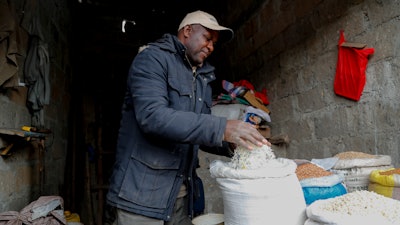
Francis Ndege isn't sure if his customers in Africa's largest slum can afford to keep buying rice from him.
Prices for rice grown in Kenya soared a while ago because of higher fertilizer prices and a yearslong drought in the Horn of Africa that has reduced production. Cheap rice imported from India had filled the gap, feeding many of the hundreds of thousands of residents in Nairobi's Kibera slum who survive on less than $2 a day.
But that is changing. The price of a 25-kilogram (55-pound) bag of rice has risen by a fifth since June. Wholesalers are yet to receive new stocks since India, the world's largest exporter of rice by far, said last month that it would ban some rice shipments.
It's an effort by the world's most populous nation to control domestic prices ahead of a key election year — but it's left a yawning gap of around 9.5 million metric tons (10.4 tons) of rice that people around the world need, roughly a fifth of global exports.
"I'm really hoping the imports keep coming," said Ndege, 51, who's sold rice for 30 years.
He isn't the only one. Global food security is already under threat since Russia halted an agreement allowing Ukraine to export wheat and the El Nino weather phenomenon hampers rice production. Now, rice prices are soaring — Vietnam's rice export prices, for instance, have reached a 15-year high — putting the most vulnerable people in some of the poorest nations at risk.
The world is at an "inflection point," said Beau Damen, a natural resources officer with the U.N. Food and Agriculture Organization based in Bangkok.
Even before India's restrictions, countries already were frantically buying rice in anticipation of scarcity later when the El Nino hit, creating a supply crunch and spiking prices.
What could make the situation worse is if India's ban on non-basmati rice creates a domino effect, with other countries following suit. Already, the United Arab Emirates has suspended rice exports to maintain its domestic stocks. Another threat is if extreme weather damages rice crops in other countries.
An El Nino is a natural, temporary and occasional warming of part of the Pacific Ocean that shifts global weather patterns, and climate change is making them stronger. Scientists expect the one underway to expand to supersized levels, and, in the past, they have resulted in extreme weather ranging from drought to flooding.
The impact would be felt worldwide. Rice consumption in Africa has been growing steadily, and most countries are heavily dependent on imports. While nations with growing populations like Senegal have been trying to grow more of their own rice — many are struggling.
Amadou Khan, a 52-year-old unemployed father of five in Dakar, says his children eat rice with every meal except breakfast, which they often have to skip when he's out of work.
"I am just getting by — sometimes, I've trouble taking care of my kids," he said.
Imported rice — 70% of which comes from India — has become prohibitively expensive in Senegal, so he's eating homegrown rice that costs two-thirds as much.
Senegal will turn to other trading partners like Thailand or Cambodia for imports, though the West African country is not "far from being self-sufficient" on rice, with over half of its demand grown locally, Agriculture Ministry spokesperson Mamadou Aïcha Ndiaye said.
Asian countries, where 90% of the world's rice is grown and eaten, are struggling with production. The Philippines was carefully managing water in anticipation of less rain amid the El Nino when Typhoon Doksuri battered its northern rice-producing region, damaging $32 million worth of rice crops — an estimated 22% of its annual production.
The archipelago nation is the second-largest importer of rice after China, and President Ferdinand Marcos Jr. has underscored the need to ensure adequate buffers.
India's rice restrictions also were motivated by erratic weather: An uneven monsoon along with a looming El Nino meant that the partial ban was needed to stop food prices from rising, Indian food policy expert Devinder Sharma said.
The restrictions will take offline nearly half the country's usual rice exports this year, said Ashok Gulati of the Indian Council for Research on International Economic Relation. Repeated restrictions make India an unreliable exporter, he added.
"That's not good for the export business because it takes years to develop these markets," Gulati said.
Vietnam, another major rice exporter, is hoping to capitalize. With rice export prices at a 15-year high and expectations that annual production to be marginally higher than last year, the Southeast Asian nation is trying to keep domestic prices stable while boosting exports.
The Agriculture Ministry says it's working to increase how much land in the Mekong Delta is dedicated to growing rice by around 500 square kilometers — an area larger than 90,000 football fields.
Already the Philippines is in talks with Vietnam to try to get the grain at lower prices, while Vietnam also looks to target the United Kingdom, which receives much of its rice from India.
But exporters like Charoen Laothamatas in neighboring Thailand are wary. The Thai government expects to ship more rice than it did last year, with its exports in the first six months of the year 15% higher than the same period of 2022.
But the lack of clarity about what India will do next and concerns about the El Nino means Thai exporters are reluctant to take orders, mill operators are unwilling to sell and farmers have increased the prices of unmilled rice, said Laothamatas, president of the Thai Rice Exporters Association.
With prices fluctuating, exporters don't know what prices to quote — because prices may spike again the next day.
"And no one wants to take the risk," Laothamatas said.






















